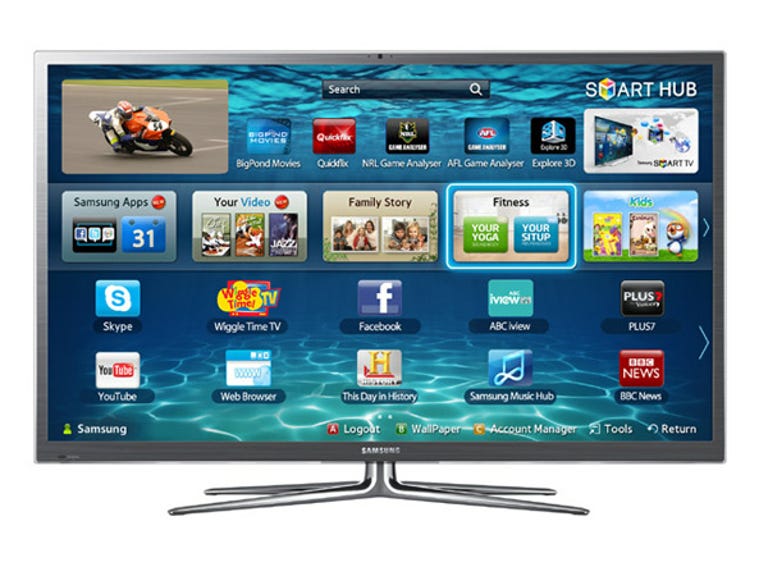 Why You Can Trust CNET
Why You Can Trust CNET Samsung PS60E8000 review: Samsung PS60E8000
The Samsung PS60E8000 plasma TV is huge, it's about as "smart" as they currently get, it delivers an excellent picture — and it's a bargain.
Elsewhere on this site, we've reviewed Samsung's new Series 8 LCD TV very positively. Now, imagine that you've added 13cm to its screen size and taken AU$1,700 off its selling price. That's pretty much what the Samsung PS60E8000 plasma TV delivers.
The Good
The Bad
The Bottom Line
It has a whopping 152cm (60 inch) full HD plasma display, packing all the networking smarts and special new features of the LCD TV. The trade-off is that it isn't as elegant in styling: it is thicker at 55mm, and its bezel is wider at 35mm on the sizes, 33mm at the top and 50mm at the bottom. Despite the large screen, the TV has a convenient swivel stand.
There are three HDMI inputs, support for component and composite video and three USB sockets. You can use one of these to plug in a hard disk drive, which then acts as a PVR, allowing recording and pausing TV shows.
Built into the top bezel of the TV is a small camera and a couple of tiny microphones. These are used for Skype, and also for the motion and voice control capabilities of this TV. The TV has Ethernet and Wi-Fi, and access to the full range of Samsung's "Smart Hub" network offerings. It comes with a regular remote control and a touch pad remote, which works via infrared (RF). There's also an RF blaster. You can program the touch pad remote to also control a Blu-ray player and PVR. The TV sends the touch pad's commands via RF to the blaster, which sends them as IR commands to the devices that are to be controlled.
And, of course, the TV delivers 3D, with two pairs of Samsung's AU$30 (per set) glasses included.
Picture
Up close, the picture from plasma isn't quite as smooth as LCD. In dark parts of the picture, the pixels are "dithered" — flashed on for only a small proportion of the time, in order achieve dark greys. At low light levels, this can be perceived if you're up close. We mention this because the TV is so big that you can perceive this effect as far as a metre away. If you sit at the recommended 2.2 metres (three times the screen height), this effect is imperceptible.
What you get — after turning off Samsung's unfortunate Sharpness control — is a smooth, detailed and rich picture. Plasma browns and greens still seem more realistic than those from LCD, although there is not much in it any more. The brightness levels were excellent. The black levels were not quite as deep as those available from the best LCD screens, but were still impressive and perfectly even across the whole screen, from corner to corner.
The 3D was excellent, and noticeably better than Samsung's LCD TV. On the black and white test pattern, the leakage of black from one eye into the white, supposed to be seen by the other eye, was just about zero percent, while the other way around it was 30 per cent. The net result was that there was basically no visible ghosting in Monsters vs Aliens. In Happy Feet Two, with full blacks and full whites in close proximity (though rendered with a wide stereoscopic spread) we did see some visible ghosting, but at a low enough level that it wasn't too intrusive.
One other trade-off against LCD is that the TV uses considerably more power. Samsung rates this TV at 4.5 stars. Our measures suggested 5.5. Either way, this is much less than current model LCDs, which are typically rated at 7 or 8 stars. This TV might cost you something like AU$100 a year more to run.
Goodies
All the goodies were identical in operation and performance to those in the Samsung 55ES8000. The voice control, for example, could switch on the TV and control things. Its usefulness varied from screen to screen and function to function. Changing volume was useless, because it only worked one notch at a time, but entering search terms into the web browser was very convenient ... if you think you'll be using your TV's web browser.
Likewise, the hand control function — in which an on-screen arrow is guided by the movement of your hand — worked well in the right places. Indeed, it was the fastest way to navigate around the Smart Hub screen.
There is an iOS control app, which didn't add much, especially as it didn't pop up a keyboard for entering text. But you can plug a keyboard into one of the USB sockets, or pair a Bluetooth keyboard to the TV for this purpose. Recent Galaxy Tablets support a "second screen" function, in which the TV can stream what it's showing over your network. But this isn't available for iOS.
If your disc collection becomes depleted and there's nothing on TV, then you can draw on an extensive range of online content, including subscription services, such as Quickflix, Foxtel and (forthcoming) Bigpond Movies.
Overall
The Samsung PS60E8000 plasma may not be quite as elegant as the company's top-of-the-line LCD, but it is bigger, lower in cost, better in 3D and identically capable in networking. We know which we prefer.


